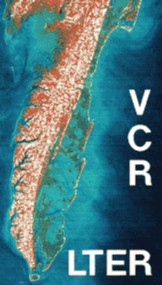 A long term analysis of root dynamics on a Hog Island sand dune grass community |

E.P. Weber, F.P. Day and S. Morrison
Biology
|
 A long term analysis of root dynamics on a Hog Island sand dune grass community |

E.P. Weber, F.P. Day and S. Morrison
Biology
|
Root dynamics in nitrogen fertilized and unfertilized plots have been observed on a 36 year old dune ridge on Hog island since 1992 using minirhizotrons. Intense sampling in the growing season of 1992 , March through late October, was followed by semiannual sampling in 1993 and 1994. Changes in root length density, mortality, and proportions of fine white roots were determined. Fertilization increased root length density in the fertilized treatment; however, the vertical distribution pattern remained the same. Root length density has continued to increase along minirhizotron tubes in both the fertilized and unfertilized treatments. An analysis of cohort mortality during the intense sampling period found that there is a clear indication of two different root age classes. There was a decline in proportion of fine white roots through the period which is due to an increase in non-fine white root production. Fertilized fine white roots also declined through time: however, the decline seems to be more sporadic. The percentage of fine white roots decreased over time for all depths in unfertilized plots. The continuation of decline in fine root proportions and continued increase in root length density over time may indicate that the root concentration surrounding the minirhizotron tubes has not yet normalized. Long term minirhizotron studies are, therefore, important in understanding both the technology of minirhizotrons and how individual roots contribute to natural systems.